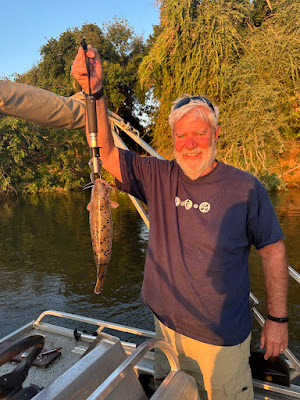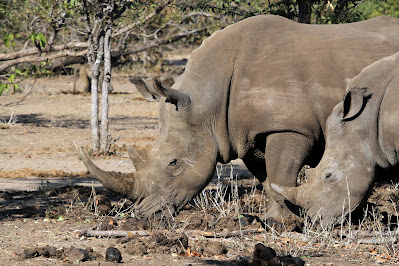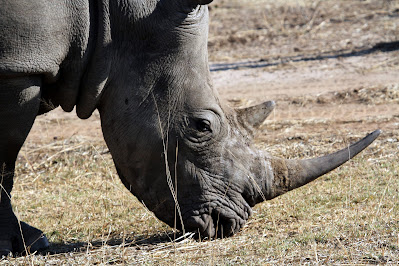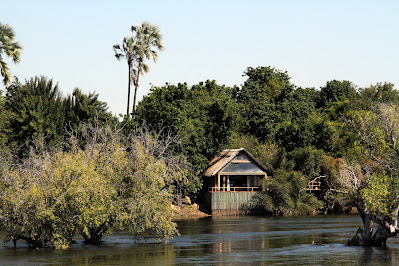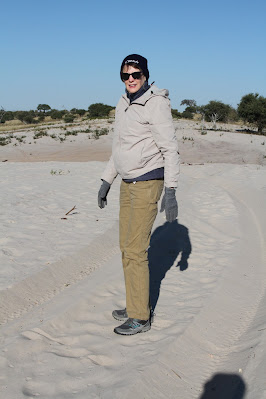 |
| Breakfast area at Potato Bush Camp |
The valet came to our tent with tea at 7:00 and we went to the breakfast area at 7:30 putting our bags outside the tent before we left. Mary and Cindy had sunny side up eggs, while Mark and I had omelets with ham and cheese. There were also muffins and breads as well as several fruits and cereals including porridge.
We said our goodbyes to the staff as we left on our last day in Africa. Clement took us along the Zambezi River to the landing where we loaded into a Land Cruiser. The couple from Ottawa met us there since we would be on the same flights as far as Johannesburg.
 |
| Cape buffalo herd near Jeki Airstrip |
 |
| Our flight to Lusaka, Zambia |
The flight boarded on time at 2:30 and departed soon thereafter. We were seated across the aisle from Mark and Cindy and were pleased to have bulkhead seats with plenty of legroom. The flight to Jo-burg was easy. A nice snack was served around 3 pm which was welcome since we had breakfast at 7:30. We landed in Jo-burg around 4:30 and began making our way through the process of entering South Africa again. Going through customs was easy as was picking up our bags. We had only checked our bags to Johannesburg which we learned may have been a mistake.
While we were in line, a rumor circulated that our flight to Atlanta would be diverted to Puerto Rico to get airline staff. We later heard that the flight would be cancelled. Since we were early, the flight wasn’t posted on the departure board yet and there was nothing on the Delta app. There was an additional checkpoint at our gate involving checking our carry-on bags for powder. Everyone on our flight had to allow their bags to be hand inspected.
We met with Mark and Cindy and found a Mug and Bean restaurant that had available seating. We and had a very good meal at an affordable price, which surprised us for airport food. The service was a little slow; we think that our server was new. When we got to the gate we noticed that about a third of the passengers were wearing camouflage. We learned that June is a very popular time for big game hunting in Central Africa.
Our flight was posted to Atlanta on time and with no scheduled layover in Puerto Rico. The flight appeared full, but we boarded early with our Comfort Class seating. Mark and Cindy were one row in front of us in Premium Class. Our seat mate was a young woman who had been hunting with her father and sister in South Africa. She had killed a kudu with 50 inch horns, a large hartebeest and a huge warthog. Her father killed a zebra and giraffe and her sister killed a wildebeest. Her father said that the hunt was far less expensive than big game hunts in North America.
As expected, the flight attendants fed us dinner at midnight. We had chicken with rice which was okay, but we only ate a little of it. We read, watched movies and tried to sleep. We only got about 2 hours of sleep during the 16-hour flight.
Landing in Atlanta was smooth, but we had a 30-minute wait for a gate. We had a message from Delta that our flight to Lexington was cancelled. Once we deplaned, we went to customs only to find that the Global Entry kiosks we not functioning for passengers on our flight. The airport staff then put us at the end of the line for regular entry. This is the second time that Global Entry slowed us down in Atlanta. We later learned that TSA had learned that our flight was canceled and removed access to the Global Entry kiosks for that flight. We were concerned that TSA was getting flight information through social media.
Once we got through customs, we had to get our flight to Lexington rescheduled before we could go through security. Mark and Cindy went through, but we waited in a lengthy line to see a Delta representative. When we got in the line there were four associates working. However, they were soon moved to another area leaving one staffer to deal with the long line. It was well over two hours by the time we were able to get to the help desk. Mary was on the Delta app the whole time waiting for assistance through the app. Once we made it to customer service we were put on a flight to Lexington that was only two hours later than our original flight. We were given standby status rather than assigned seats. Although we had paid for upgraded seats, we would be happy with any seat for the 90-minute flight.
We got through security easily then met Mark and Cindy for lunch. The food court area was packed so there was no room in any sit-down restaurant. Mark and Cindy bought pizza slices, and we got McDonalds. The service at our McDonald’s was terrible: the young man at the register was rude to everyone, and the food was slow and cold. We joked that the staff in African airports was friendlier, and more people spoke English than in the Atlanta airport.
At our gate we saw that we were numbers 22 and 23 awaiting seat assignments for the flight to Lexington. We saw another Delta representative who said that we were highly likely to get a seat on the flight and that another flight to Lexington was scheduled later in the evening.
Once standby passengers were assigned seats, we were pleased that were were in our upgraded seats for the short flight to Lexington. The flight was only a little late for departure since a passenger was concerned that bags had been misdirected. Our seat mate on the flight was expressing his frustration with a few minutes of delay by huffing and puffing, stamping his feet and just being annoying.
Like prior flights, we read during the short hop to Lexington. Our checked bags made it quickly to the carousel, and we met Ian outside who took us home and helped us with our bags.
It was the trip of a lifetime, but it is great to be home. We have a lot of laundry to do and weeds to clear from the gardens. The neighbor, Sam, kept the yard mowed, but we needed to mow the field and around the trees. We kept the thermostat set to 80 degrees in the house while we were gone, but we took it down a few degrees now that we are home.
We will miss a lot of things about Africa. Having meals custom prepared for us was nice. Having wine and mixed drinks brought to us, tea delivered to our rooms when we woke were great. The biggest thrill was going to the places that Mutual of Omaha’s Wild Kingdom visited. We saw the African Big Five (lion, leopard, elephant. rhinoceros and Cape buffalo) and the African Ugly Five (hyena, vulture, wildebeest, marabou stork and warthog). We saw only two of the African tiny five (buffalo weaver and antlion).
Given the cost and time involved, it is unlikely that we will return to Botswana and Zambia. However, we will hold the memories of our time in Central Africa forever.
We got through security easily then met Mark and Cindy for lunch. The food court area was packed so there was no room in any sit-down restaurant. Mark and Cindy bought pizza slices, and we got McDonalds. The service at our McDonald’s was terrible: the young man at the register was rude to everyone, and the food was slow and cold. We joked that the staff in African airports was friendlier, and more people spoke English than in the Atlanta airport.
At our gate we saw that we were numbers 22 and 23 awaiting seat assignments for the flight to Lexington. We saw another Delta representative who said that we were highly likely to get a seat on the flight and that another flight to Lexington was scheduled later in the evening.
Once standby passengers were assigned seats, we were pleased that were were in our upgraded seats for the short flight to Lexington. The flight was only a little late for departure since a passenger was concerned that bags had been misdirected. Our seat mate on the flight was expressing his frustration with a few minutes of delay by huffing and puffing, stamping his feet and just being annoying.
Like prior flights, we read during the short hop to Lexington. Our checked bags made it quickly to the carousel, and we met Ian outside who took us home and helped us with our bags.
It was the trip of a lifetime, but it is great to be home. We have a lot of laundry to do and weeds to clear from the gardens. The neighbor, Sam, kept the yard mowed, but we needed to mow the field and around the trees. We kept the thermostat set to 80 degrees in the house while we were gone, but we took it down a few degrees now that we are home.
We will miss a lot of things about Africa. Having meals custom prepared for us was nice. Having wine and mixed drinks brought to us, tea delivered to our rooms when we woke were great. The biggest thrill was going to the places that Mutual of Omaha’s Wild Kingdom visited. We saw the African Big Five (lion, leopard, elephant. rhinoceros and Cape buffalo) and the African Ugly Five (hyena, vulture, wildebeest, marabou stork and warthog). We saw only two of the African tiny five (buffalo weaver and antlion).
Given the cost and time involved, it is unlikely that we will return to Botswana and Zambia. However, we will hold the memories of our time in Central Africa forever.
















